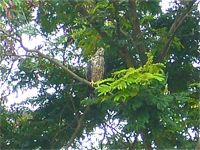“I’ve always been fascinated by the variety of birds that visit the trees in the field across the road from my house near Aljunied Park. On a soggy Sunday afternoon yesterday, I could not help noticing some activity in one of the large trees that directly faces my bedroom. Between about 4.00pm and 5.15pm, when the continuous all-day drizzle took a brief respite, these birds came by:
4 Black-naped Orioles (Oriolus chinensis), 1 Golden-bellied Gerygone (Gerygone sulphurea), 3-4 White-vented Mynas (Acridotheres grandis), 2-3 House Crows (Corvus splendens), Asian Brown Flycatcher (Muscicapa dauurica), 2 Arctic Warblers (Phylloscopus borealis), 2 Scarlet-backed Flowerpeckers (Phylloscopus borealis ), 3-4 Olive-backed Sunbirds (Cinnyris jugularis), 2 Spotted Doves (Streptopelia chinensis), 1 Yellow-vented Bulbul (Pycnonotus goiavier), 2 White-throated Kingfishers (Halcyon smyrnensis) (perched on fence under tree) – actively fishing from the field that had ponded below the tree, 1 Collared Kingfisher (Todiramphus chloris), 2 Rock Pigeons (Columba livia) and an Asian Koel (Eudynamys scolopacea) heard.
“I have also noted these other birds that have come by in the past 1.5 years: Oriental Honey Buzzard (Pernis ptilorhyncus) (right) – pair spotted on 4 Sep 07, followed by random sightings of one bird a few times after that in the following few months, the last sighting being on 9 Feb 08; Common Ioras (Aegithina tiphia); White-breasted Waterhen (Amaurornis phoenicurus) – 1 appeared in Dec 07 when field ponded after heavy rains, re-appeared a few times when field ponds; Brown-throated Sunbirds (Anthreptes malacensis); Red-breasted Parakeets (Psittacula alexandri) – noisy flock of 10-12 appeared suddenly in early Dec 07 every morning for a week, then disappeared as suddenly; Sunda Pygmy Woodpeckers (Cacatua goffini); Asian Glossy Starlings (Aplonis panayensis); Pied Triller (Lalage nigra); Brown Shrike (Lanius cristatus); Common Tailorbirds (Orthotomus sutorius); Eurasian Tree Sparrows (Passer montanus); Oriental White-eye (Zosterops palpebrosus); and Large-tailed Nightjar (Caprimulgus macrurus) (heard frequently at night).
“Not sure if all/any of this is noteworthy, but thought I’d submit it for the record somewhere.”
Lena Chow
Singapore
15th December 2008
Comment by YC Wee: An impressive list indeed, 27 species in all and sure to make any lister proud. With Singapore being a Garden City, it is becoming convenient to bird-watch in the comfort of one’s home environment. And at the same time make valuable observations on bird behaviour. You need not take any extra efforts to seek out birds. They come right to your doorsteps and begged to be observed.
The sad part is that most veteran local birdwatchers consider many of the above species “trash” birds and tend to simply ignore them. By posting this long list and reminding birdwatchers of the ease of observing birds, it is hoped that more will actually do so…










5 Responses
I’m envious.
By the way, is Lena actually referring to Javan myna (Acridotheres javanicus)?
Yes, the reference should be to Acridotheres javanicus. By the way, Bird #28 showed up yesterday – a female Common Flameback (Dinopium javanense).
Actually in the region of Peninsular Malaysia and Singapore, our richness in aviandiversity usually promised us at least around 50 species of birds to be seen in the averaged urban gardens with at least some trees, we couldn’t say it is true for areas that are completely without trees, but a few species manage to survive there as well.
My garden in Ipoh for example, just counting those passing my house, I have 60 over species over the last 12 years of birdwatching, in a close by 5 minute walking zone, another 10-20 are recorded before, and in a wider area that I considered as my whole birdwatching area, I now have 108 species confirmed in my local list, with another 10+ in KIV as they were either not clearly observed for a positive ID or is based on unconfirmed records of the locals.
With my garden, it as elements of urban housing, wooded garden, wooded scrubland, open wasteland, secondary growth and small pocketed wetlands, this is definitely very diversed in birds and would definitely be expecting more in the future. My personal target is to at least get up to 150 species. Now, I only only missing shy species, hard to expect species and potential passing migrants.